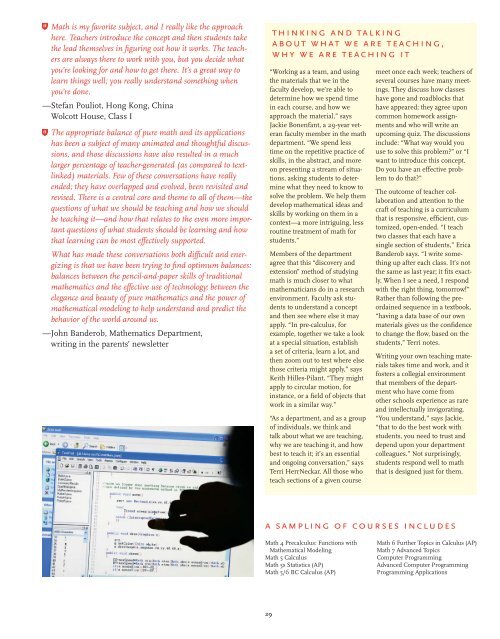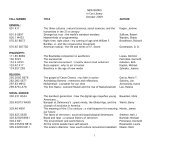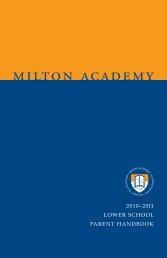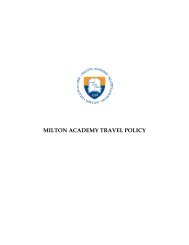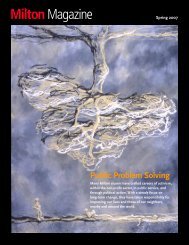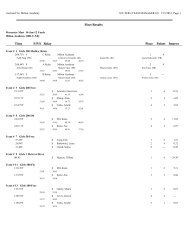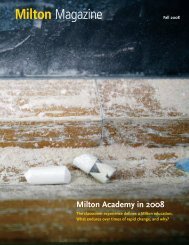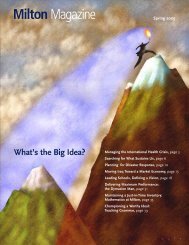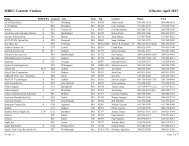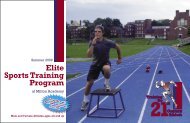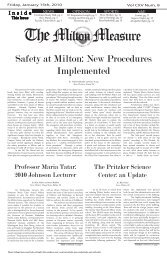Contents - Milton Academy
Contents - Milton Academy
Contents - Milton Academy
- No tags were found...
Create successful ePaper yourself
Turn your PDF publications into a flip-book with our unique Google optimized e-Paper software.
Math is my favorite subject, and I really like the approachhere. Teachers introduce the concept and then students takethe lead themselves in figuring out how it works. The teachersare always there to work with you, but you decide whatyou’re looking for and how to get there. It’s a great way tolearn things well; you really understand something whenyou’re done.— Stefan Pouliot, Hong Kong, ChinaWolcott House, Class IThe appropriate balance of pure math and its applicationshas been a subject of many animated and thoughtful discussions,and those discussions have also resulted in a muchlarger percentage of teacher-generated (as compared to textlinked)materials. Few of these conversations have reallyended; they have overlapped and evolved, been revisited andrevised. There is a central core and theme to all of them—thequestions of what we should be teaching and how we shouldbe teaching it—and how that relates to the even more importantquestions of what students should be learning and howthat learning can be most effectively supported.What has made these conversations both difficult and energizingis that we have been trying to find optimum balances:balances between the pencil-and-paper skills of traditionalmathematics and the effective use of technology; between theelegance and beauty of pure mathematics and the power ofmathematical modeling to help understand and predict thebehavior of the world around us.— John Banderob, Mathematics Department,writing in the parents’ newsletterthinking and talkingabout what we are teaching,why we are teaching it“Working as a team, and usingthe materials that we in thefaculty develop, we’re able todetermine how we spend timein each course, and how weapproach the material,” saysJackie Bonenfant, a 29-year veteranfaculty member in the mathdepartment. “We spend lesstime on the repetitive practice ofskills, in the abstract, and moreon presenting a stream of situations,asking students to determinewhat they need to know tosolve the problem. We help themdevelop mathematical ideas andskills by working on them in acontext—a more intriguing, lessroutine treatment of math forstudents.”Members of the departmentagree that this “discovery andextension” method of studyingmath is much closer to whatmathematicians do in a researchenvironment. Faculty ask studentsto understand a conceptand then see where else it mayapply. “In pre-calculus, forexample, together we take a lookat a special situation, establisha set of criteria, learn a lot, andthen zoom out to test where elsethose criteria might apply,” saysKeith Hilles-Pilant. “They mightapply to circular motion, forinstance, or a field of objects thatwork in a similar way.”“As a department, and as a groupof individuals, we think andtalk about what we are teaching,why we are teaching it, and howbest to teach it; it’s an essentialand ongoing conversation,” saysTerri HerrNeckar. All those whoteach sections of a given coursemeet once each week; teachers ofseveral courses have many meetings.They discuss how classeshave gone and roadblocks thathave appeared; they agree uponcommon homework assignmentsand who will write anupcoming quiz. The discussionsinclude: “What way would youuse to solve this problem?” or “Iwant to introduce this concept.Do you have an effective problemto do that?”The outcome of teacher collaborationand attention to thecraft of teaching is a curriculumthat is responsive, efficient, customized,open-ended. “I teachtwo classes that each have asingle section of students,” EricaBanderob says. “I write somethingup after each class. It’s notthe same as last year; it fits exactly.When I see a need, I respondwith the right thing, tomorrow!”Rather than following the preordainedsequence in a textbook,“having a data base of our ownmaterials gives us the confidenceto change the flow, based on thestudents,” Terri notes.Writing your own teaching materialstakes time and work, and itfosters a collegial environmentthat members of the departmentwho have come fromother schools experience as rareand intellectually invigorating.“You understand,” says Jackie,“that to do the best work withstudents, you need to trust anddepend upon your departmentcolleagues.” Not surprisingly,students respond well to maththat is designed just for them.a sampling of courses includesMath 4 Precalculus: Functions withMathematical ModelingMath 5 CalculusMath 5s Statistics (AP)Math 5/6 BC Calculus (AP)Math 6 Further Topics in Calculus (AP)Math 7 Advanced TopicsComputer ProgrammingAdvanced Computer ProgrammingProgramming Applications29


